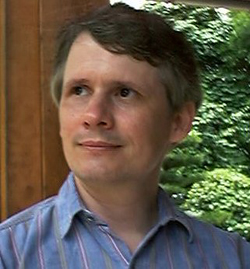Dr. Thomas S. Ray
Dr. Thomas S. Ray earned undergraduate degrees in biology and chemistry at Florida State University. He received his Masters and Doctorate in Biology from Harvard University, specializing in plant ecology. He was a member of the Society of Fellows of the University of Michigan at Ann Arbor. In 1981 he joined the faculty of the University of Delaware, School of Life and Health Sciences. In 1993, he received a joint appointment in Computer and Information Science at U. of Delaware, and was appointed to the External Faculty of the Santa Fe Institute. In August of 1993, he joined the new Evolutionary Systems Department at ATR (Advanced Telecommunications Research Institute International) Human Information Processing Research Labs in Japan, as an invited researcher. In August 1998 he became a Professor of Zoology at the University of Oklahoma, with an adjunct appointment as Professor of Computer Science.
Over the years, Tom has been involved in three completely different research programs:
From 1974 to 1989, Tom was a tropical biologist who studied the evolution and ecology of a variety of organisms inhabiting rain forests. His work focused primarily on the foraging behavior of vines in the family Araceae, however, he has also studied ants, butterflies and beetles. Most of his field work has been conducted in Costa Rica. After 1982, he worked principally at Finca El Bejuco biological station located in the lowland rain forests of northern Costa Rica, which he built, owns and operates. He was deeply involved in rain forest conservation in Costa Rica.
From 1990 to 2001, he conducted research on evolution in the digital medium. This work began with the creation of Tierra, a system in which self-replicating machine code programs evolved by natural selection. In 2000, he implemented a system called Virtual Life, which is a derivative of Evolved Virtual Creatures originally created by Karl Sims.
In the summer of 2001, Tom began his third major research direction, which is actually two somewhat related research programs. One is an exploration of the newly created genome databases, with a broad interest in interesting discoveries that might be made there. He is using the genome databases to study the origin and evolution of gene families. He is also exploring the possibility that the genomic data may provide new approaches for understanding the human mind. The new genome databases can provide a complete catalog of chemical communication systems in the brain. They have the potential of providing a comprehensive understanding of the processes of development and differentiation that generate the architecture of the brain. And by comparing human and ape genomes, they can point to the neural structures that make us uniquely human. The second area of research that he is developing is the use of pharmacology as an experimental approach to understand the chemical organization of the brain and the mind that emerges from it.
His publications include Kurzweil’s Turing Fallacy, Aesthetically Evolved Virtual Pets, Evolution of Complexity: Tissue Differentiation in Network Tierra, Selecting Naturally for Differentiation: preliminary evolutionary results, Evolving Parallel Computation, Evolution, Complexity, Entropy, and Artificial Reality A proposal to create a network-wide biodiversity reserve for digital organisms, and How I created life in a virtual universe.
Tom has received media coverage in many countries including the United States, United Kingdom, Canada, Japan, Costa Rica, France, Belgium, Sweden, Finland, Italy, Germany, Holland, Brazil, Norway, Denmark, Switzerland, Bulgaria, and Turkey.
